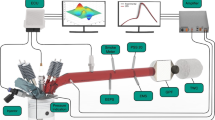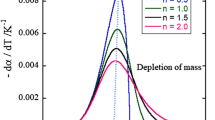Abstract
From the viewpoint of morphology and internal structure soot collected in exhaust gases of engines and carbon blacks are identical materials. They are made of aggregates of pseudospherical particles; the size of individual particles goes from ca. 10 to 500 nm; a single aggregate can include several tens of particles.
The morphology (size and shape) of aggregates can be characterized by electron microscopy, scattering and absorption of light, ultracentrifugation and also adsorption of gases and liquids (pure liquids and solutions).
Electron microscopy has been used to give a two dimensional description of aggregates; the development of Quantimets permitted a quantitative description of soot. The third dimension of carbon black aggregates can be investigated by using electron microscopy combined with stereoscopic methods (observation under two different angles).
Scattering and absorption of light allow one to compute equivalent diameters of aggregated particles.
Ultracentrifugation, carried out on suspensions in water, gives equivalent Stokes diameter distributions of carbon blacks.
A convenient technique has become standard; it is based on the absorption of oil or dibutyl-phthalate in the voids between the particles constituting the aggregates.
Specific surface areas and porosity of soot are currently determined by gas adsorption (essentially nitrogen at the temperature of liquid nitrogen). Iodine adsorption from iodine solution in water has also become standard practice.
The internal structure of carbon blacks (i.e. the crystalline organization of carbon inside the material) has been systematically studied by X-ray diffraction, electron microscopy of oxidized particles, dark field and phase contrast electron microscopy.
The crystalline structure is essentially graphitic (turbostratic). Layer planes of carbon are the basic building blocks of carbon black; they are partially oriented parallel to the surface but also around centers inside the particles.
External layer planes are continuous from one particle to its neighbors. Therefore, in the final material, individual particles have no real existence; the aggregate is the constituent unit of soot.
Access this chapter
Tax calculation will be finalised at checkout
Purchases are for personal use only
Preview
Unable to display preview. Download preview PDF.
Similar content being viewed by others
References
J. B. Donnet and A. Voet, “Carbon Black — Physics, Chemistry and Elastomer Reinforcement”, Marcel Dekker Inc. (1976).
J. Lahaye and G. Prado, in “Chemistry and Physics of Carbon”, Edit. by P. L. Walker and P. A. Thrower, Marcel Dekker Inc., Vol. 14 (1978), pp. 168–294.
A. I. Medalia and D. Rivin, in “Characterization of Powder Surfaces”, Edit. by G. D. Parfitt and K. S. W. Sing, Academic Press (1976) pp. 279–351.
L. H. Cohan and J. H. L. Watson, Rubber Age, Vol. 68 (1951), p. 687.
A. I. Medalia and F. A. Heckman, Carbon, Vol. 7 (1969), p. 562.
C. Fisher and M. Cole, The Microscope, Vol. 16 (2), (1968), p. 81.
C. Fisher, The Microscope, Vol. 19 (1), (1971), p. 1.
W. M. Hess, L. L. Ban and G. C. Mc Donald, Rubber Chem. Technol., Vol. 42 (1969), p. 1209.
W. M. Hess, G. C. Mc Donald and E. Urban, Rubber Chem. and Technol., Vol. 46 (1), (1973), p. 204.
E. Redman, F. A. Heckman and J. E. Connolly, “Particle size analysis conference Proceedings”, 3d, (1978), p. 51.
M. Rink, J. Microsc. Oxford, Vol. 107 (1976), p. 267.
H. N. Mercer, A. H. Boyer, P. L. Brusky and M. L. Deviney, Rubber Chem. and Technol., Vol. 49 (4), (1976), p. 1068.
H. N. Mercer, A. H. Boyer and M. L. Deviney, Rubber Chem. and Technol. Vol. 52 (2), (1979), p. 377.
E. Redman, F. A. Heckman and J. E. Connoly, Meeting of the Rubber Division, American Chemical Society, Chicago, Ill. 1977; Abstract in Rubber Chem. Technol., Vol. 50 (1977), p. 1000.
J. B. Donnet, C. Eckhardt and A. Voet, Rev. Gen. Gaontchouc Plast. Vol. 44 (5), (1967), p. 627, Vol. 44 (12), (1967), p. 1505.
S. Premilat and P. Horn, J. Chim. Phys., Vol. 63 (3), (1966), p. 463.
J. C. Ravey and S. Premilat, J. Chim. Phys., Vol. 67 (1), (1970), p. 147.
J. C. Ravey and S. Premilat, J. Chim. Phys., Vol. 67 (I), (1970), p. 157.
F. A. Heckman, E. Redman and J. E. Conolly, Complementary Studies of Carbon Black Aggregate Morphology by Analytical Centrifugation and Quantitative Image Analysis -Technical Service Report Cabot Corporation, Spring (1977).
ASTM D 2414–65, Standard Method of Testing, Carbon Black — Dibutyl Phthalate Absorption Number, American Society for Testing and Materials, Philadelphia, Pa., (1966).
B. Schubert, F. P. Ford and F. Lyon, Analysis of Carbon Black, Encyclopedia of Industrial Chemical Analysis John Wiley and Sons, Inc., Vol. 8 (1969), p. 225.
A. I. Medalia, J. Colloid Interf. Sci., Vol. 32 (1970), p. 115.
M. Bastick, P. Chiche and J. Rappeneau, Les Carbones — Tome II (Masson et Cie), (1965), pp. 24–160.
W. R. Smith, Rev. Gen. Caoutchouc, Vol. 41 (1964), p. 367.
N. N. Avgul and A. V. Kiselev, “Chemistry and Physics of Carbon”, P. L. Walker Jr., Marcel Dekker, New York, Vol. 6 (1970).
W. H. Wade, M. L. Deviney, W. A. Brown, M. H. Knoosch, and D. R. Wallace, Rubber Chem. Technol., Vol. 45 (1972), p. 117.
ASTM D 1510–65, Method of Tests for Iodine Adsorption Number of Carbon Black, American Society for Testing and Materials, Philadelphia, Pa, (1966).
F. Z. Saleeb and V. A. Kitchener, J. Chem. Soc. (1965), p. 911.
V. C. Abram and M. C. Bennett, J. Colloid Interf. Sci., Vol. 27 (1968), p. 1.
G. Prado, PhD Dissertation Thesis, Strasbourg University, (1972).
G. Prado, and J. Lahaye, J. Chim, Phys., Vol. 4 (1975), p. 483.
B. E. Waren, J. Chim. Phys. Vol. 2 (1934), p. 551.
J. Mering et J. Maire, Les Carbones, Tome I (Masson & Cie), (1965), p. 162.
A. E. Austin, Proceeding 3rd Conf. on Carbon, (1958), p. 389.
S. Ergun, Carbon, Vol. 6 (1968), p. 141.
E. A. Kmetko, Proc. 1st and 2nd Conf. on Carbon, (1956), p. 21
H. P. Boehm, Z. Anorg. Allgem. Chem., Vol. 297 (1958), p. 315.
H. Akamatu and H. Kuroda, Proc. 4th Conf. on Carbon, (1960), p. 363.
V. L. Kasatotshkin, V. M. Lukianovitch, N. M. Popov and K. V. Tschmutov, J. Chim. Phys., Vol. 52 (1964), p. 822.
F. A. Heckman and D. E. Harling, Rubber Chem. Technol. Vol. 39 (1966).
J. B. Donnet and J. C. Borland, Rev. Gen. Caoutchouc, Vol. 41 (1964), p. 407.
A. Oberlin, Carbon, Vol. 17 (1979), p. 7.
R. D. Heidenreich, W. M. Hess and L. L. Ban, J. Appl. Cryst., Vol. 1 (1968), p. 1.
W. M. Hess, L. L. Ban, F. J. Eckert and V. Chirico, Rubber Chem. Technol., Vol. 41 (1968), p. 356.
P.A. Marsh, A. Voet, T. J. Mullens and L. D. Price, Carbon, Vol. 9 (1971), p. 797.
Author information
Authors and Affiliations
Editor information
Editors and Affiliations
Rights and permissions
Copyright information
© 1981 Springer Science+Business Media New York
About this chapter
Cite this chapter
Lahaye, J., Prado, G. (1981). Morphology and Internal Structure of Soot and Carbon Blacks. In: Siegla, D.C., Smith, G.W. (eds) Particulate Carbon. Springer, Boston, MA. https://doi.org/10.1007/978-1-4757-6137-5_2
Download citation
DOI: https://doi.org/10.1007/978-1-4757-6137-5_2
Publisher Name: Springer, Boston, MA
Print ISBN: 978-1-4757-6139-9
Online ISBN: 978-1-4757-6137-5
eBook Packages: Springer Book Archive




